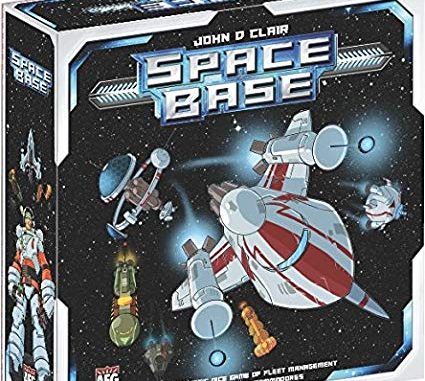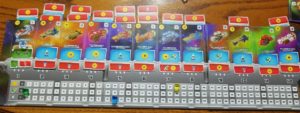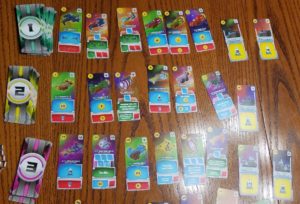
This game has become my son’s new favorite obsession. After opening it at Christmas we had to play it every day for the next week. It slowed down after that but only because there’s more to do at home.
Gameplay- A
The goal of the game is to accumulate the most victory points. The first person to get to 40 VP triggers the final round. This puts player one at a disadvantage over the last player, as if 1st Player gets 40 VP on their turn, everyone else will have a chance to get over 40. If last player gets 40 VP first, then game over.
 Gameplay each turn consists of three basic parts. First, you roll a pair of d6. Then you get rewards based on the results. You can take the dice as a sum (2+6=8) or individually (2 & 6). If it’s your turn, you get the rewards in the blue box corresponding to the rewarded number. If it’s an opponent’s turn, you get the reward in the red boxes above the board.
Gameplay each turn consists of three basic parts. First, you roll a pair of d6. Then you get rewards based on the results. You can take the dice as a sum (2+6=8) or individually (2 & 6). If it’s your turn, you get the rewards in the blue box corresponding to the rewarded number. If it’s an opponent’s turn, you get the reward in the red boxes above the board.
Example: If you took an 8 on your turn, you would earn 4 VP (the little rocket icon). If you took 2 & 6 you would earn 2 VP and 3 Credits (the yellow circle). If it had been your opponent’s turn, you would have received 2 Credits for an 8 or 6 Credits and 1 VP for a 2 & 6.
 After you get your rewards, you can then buy a card with whatever credits (yellow cube track) you have. The trick here is you have to spend all of your credits. So if you have five credits and you buy a card that costs four, you still go down to zero. Once your purchase is done, your credits will move up to match your Income (the green cube/symbol). This forces you to decide to save your money for a better card or get something small each round.
After you get your rewards, you can then buy a card with whatever credits (yellow cube track) you have. The trick here is you have to spend all of your credits. So if you have five credits and you buy a card that costs four, you still go down to zero. Once your purchase is done, your credits will move up to match your Income (the green cube/symbol). This forces you to decide to save your money for a better card or get something small each round.
There are two types of cards you can buy; starships and colonies. Starships are the majority of your purchases. There are three tiers of starships with six from each tier available for purchase at any time. Tier 1 starships cost from 2 to 5 credits. Tier 2 cost from 6 to 9 credits. And Tier 3 cost from 11 to 14 credits.
Each starship has four features. In the upper left corner is the purchase cost in credits (yellow number). In the upper right is the Sector number. The sector number tells you which slot on your player game board a card goes. If you buy a sector 4 card, you’ll then take the card you have in sector 4, flip it over so the red portion is visible above the game board and place the new card on the game board in the now empty sector 4 slot.
When you start the game you’ll have only one card above the board so the early game is all about getting cards up top. Because you get rewards on every dice roll, if your opponent rolls a number that you have empty up top you get nothing. Fortunately, because you can take the dice as a sum or separately, you do not have to replace every starting card to ensure rewards with every roll.
In addition to the straightforward rewards (Credits, Income, VP) starships can also have Action rewards. Some trigger if you roll their number. But most actions need to be charged first. To charge an action you need to roll that number which grants you a charge cube you can place on the card. If the action is Blue you can use it on your turn. If it is Red you can use it on an opponents turn. If it’s Green you can use it anytime.
Green abilities typically allow you to modify the dice result in some way. Some have an arrow and two dice on them. When you take the sum of the dice you can spend the charge to shift the sector over. For example, if you rolled 5+5 and took it as a 10, you could spend a charge on one of those to make it an 11.
Typically, the higher the number sector, the more valuable the starship’s reward tend to be. There is even a sector 12 card that allows you to just outright win the game regardless of anyone’s VP. It requires charging at least twice though, and naturally rolled twelves are rare. My son almost won a game once with it once.
The game plays very different depending on the number of players. In a 2-3 player game, you will have a turn far more frequently than in a 5 player game. The more players, the more valuable the red rewards are, since your opponents will roll dice four times for every time you roll them. But in a 2 player game, it’s 50/50. That changes the calculus about what kind of starships you want to buy.
Games go relatively quickly and with few exceptions is the game ever a runaway victory for someone. Because of randomness of what starships are drawn, when and what die results are rolled it’s possible for someone to just dominate through sheer dumb luck. Getting a card that generates VP early on and then getting lucky that the number keeps getting rolled can build up VP fast. But that’s the nature of randomness.
For the most part, games will run pretty smoothly and close. We’ve had a few games where someone appeared to be a clear front runner (acquiring steady VP) but then get usurped by other players who have been building their economy enough they can buy a few quick Colonies.
Colonies are the other type of card you can purchase. They award immediate VP but then lock down a particular sector. If you buy the #3 sector colony, you’ll get the immediate VP, move the starship in the #3 sector to the top and then place the colony down. You can no longer buy anything for the #3 sector and if 3 is rolled on your turn, you get nothing for a reward. This makes Colonies perfect for jumping ahead to victory but bad investments early on.
Production- A-
The game’s components are all well made. You track your progress with colored cubes (identical to Pandemic disease cubes). The player’s game board lays out your play area with everything you need to keep track of. A nice little touch there is that the background for the cards all match the background of the game board in their sector slot. Additionally, the game box has ample slots for all of the components. You could probably fit more from potential expansions in the core box as well.
The only downside to the components comes when you’re trying to slot cards above the player game board. You do this a lot but it can be frustrating to do. The cards do not slide underneath each other most of the time without picking them all up. It is also easy to accidentally slide the player game board over top of your cards and lose some underneath it.
Theme- A/B-
This is a hard one to gauge. On one hand, they really go all in on the game’s theme. Each card is a starship with a unique name and hull number. Different types of ships do similar type actions. They have a complete fleet list in the back of the book. The designers clearly love their spaceships.
That all said, the actual gameplay really has nothing to do with the theme. Once you start playing the theme has no impact. You select cards that help you get victory points. Not that it hurts the gameplay in anyway but if you were looking to feel like you’re controlling a space fleet you’re out of luck there.
Expansions- TBD
There are two expansions available for Space Base. We have not tried them but one of them looks pretty cool. The Emergence of Shy Pluto looks to be a story based legacy game. Not sure how it will work but it sounds cool. The other expansion, Command Station, expands the game from max five to up to seven players. It also comes in a bigger box to store future expansions and has card sleeves. However, I’ve read that the cards, while sleeved, don’t actually fit in the box all that well so this has me thinking to skip this one. We’ll never play seven players anyways.
Conclusion- A
This game is a lot of fun. It requires some thinking and planning when deciding which rewards to take and what starships to buy. Do you load up your sectors 1-6 and get typically weaker but double rewards each roll? Or do you go for exotic combos to do some shenanigans with the more advanced numbers? It is a dice/card game so there is a lot of randomness that affects the final outcome. But unlike something like Cataan, it’s pretty easy to mitigate the randomness and ensure you’re getting resources every dice rool.
